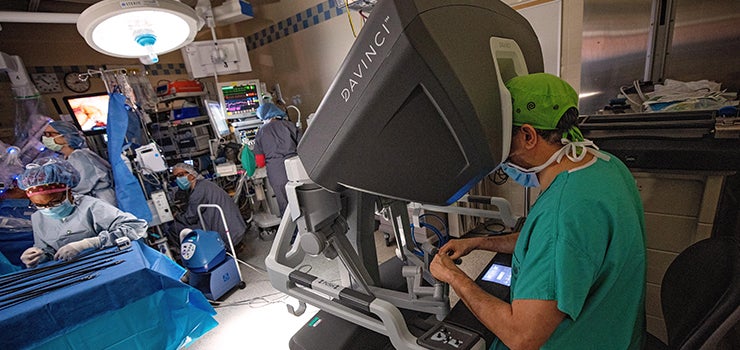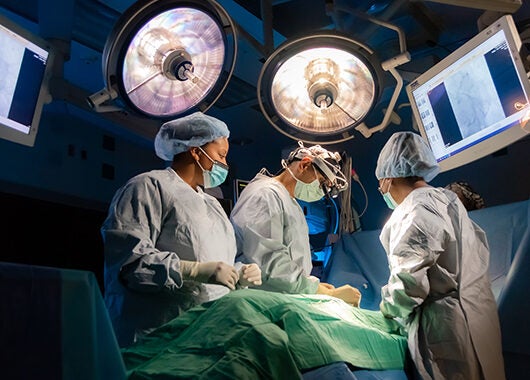ROBOT SURGERY RESEARCH
How should medical schools grapple with teaching new technologies?
Advances in medical technologies – from medicines and physical therapies to implants and surgical methods – come in a flurry that often seems impossible to keep pace with. One ethical quandary faced by East Carolina University professors instructing students at the Brody School of Medicine is how to incorporate robot-mediated surgery into the course of study for doctors on the path to becoming the next generation’s surgeons.
Robotic surgery was first pioneered by the Department of Defense, with an eye to allowing doctors, stationed in safe locations, the ability to remotely perform lifesaving surgeries much closer to the point of wartime trauma. The hopes of extended distances between patient and surgeon never materialized, but the use of the devices took off in clinical practices the 1980s.
Over time, the promise of robotic surgeries as a minimally invasive surgical approach took hold in the public consciousness. ECU surgeons were early adopters of robotic surgery techniques in the early 2000s, sharing expertise with surgeons who travelled from around the world to Pitt County Memorial Hospital in Greenville, then the teaching hospital for ECU medical students.

Surgeons at ECU Health Medical Center use a robotic device for a surgical procedure.
A 2020 study of 73 hospitals across the United States found an increase in the use of robots for surgery, from 1.8% to just over 15%, from 2012 to 2018. The study’s researchers concluded that, while use of robots in the place of laparoscopic or traditional open surgery had increased, results for common cancer surgeries did not improve. In some cases, the surgical outcomes were actually worse for robot-mediated surgeries.
ECU’s Dr. James Whiteside was a fellow at The Cleveland Clinic in 2002 and the hospital had a surgical robot that he said, “sat in the corner and no one knew what to do with it.” Cleveland Clinic surgeons were among those who trained at ECU.
Years later, practicing at Dartmouth-Hitchcock Medical Center in New Hampshire, Whiteside experienced a similar lack of understanding from hospital leadership how to integrate the new technology in the face of existing minimally invasive surgical techniques.
Dr. Clint Parker is a nephrologist by training but also teaches medical ethics to Brody students. Throughout history, Parker said, new technologies, procedures – and especially medications – have been disruptive, expensive and haven’t always equaled the positive outcomes for patients as existing methods – but in time they often prove their value.
“There is always a transition period where the costs of the technology are higher and the benefits may not be quite as good, but then as people become trained and the technology becomes more readily available, the cost goes down and complication rates go down,” Parker said. “When CT scanners first came out only the big hospitals had them. Should we have taught only emphasizing physical exam skills so that as a doctor you can make the diagnosis without becoming reliant on the on the CT scan? Now emergency departments in eastern North Carolina, they are going to have a CT scanner. We want to make sure they know the traditional ways, but we also want to train them in the new methods until the tipping point occurs.”
From an ethical perspective, Parker has a few questions about the adoption of any new technology, including robot-mediated surgery: Is the new technology better or not, especially for patient outcomes? Is the increased cost worth the return on investment?
“At the very basic level, regardless of whether it’s new or old, you want the intervention that’s going to provide the best outcomes. And then the cost part of it,” Parker said. “Even though the technology costs more money, is it going to save money on the back end?”
Whiteside’s research
The outcomes of existing studies got Whiteside wondering if robotic techniques are beneficial in one of the most commonly performed surgeries that he is familiar with, hysterectomies – not only in terms of medical outcomes, but financially, as well.
Whiteside and his collaborators designed two studies, published in 2023, to determine two things: if the robotic surgery approach was clinically better for patients and what the cost differences, if any, are. The study relied on Medicare models to normalize the financial data, to be able to “compare apples to apples,” Whiteside said, due to the incredible variation across the country in hospital charges and the cost of supplies.
“One of the problems in comparing surgical costs is the Cleveland Clinic or the University of Southern California will have different costs because they have different contracts with supply vendors. If you model it on Medicare cost delivery, you flatten regional differences,” Whiteside said.
Whiteside’s April 2023 study pored over data from 264,717 hysterectomies performed by 5,000 surgeons nationwide, including the age, sex and frequency of surgeries performed by each. Controlling for a variety of factors, Whiteside’s research team determined that hysterectomies performed with the robot cost about $1,500 more than established minimally invasive surgical approaches. The increased price of robotic surgeries, Whiteside said, can be attributed to both supply and amortized costs – purchase of the machine and regular maintenance.
One way to explain the willingness for patients to request robotic surgeries is a general lack of medical literacy, Whiteside said. The landmark RAND Health Insurance Experiment showed that patients receive about the same health care outcomes regardless of their out-of-pocket expenses for treatment.
“A related conclusion,” Whiteside said, “was that as people paid more for their health care, they did not necessarily pursue ostensibly higher value care options, which is understandable given accessing and meaningful quality measures to weigh against those rising costs remains difficult.”
In a society that values technology and the newest, shiniest thing, the promise of robotic surgery trumps seemingly outmoded methods.
Many surgeons also use the technology as a selling point for a consuming public that expects advances in high-tech tools to render the best outcomes. Whiteside recently had a patient referred to him who specifically asked for her hysterectomy to be performed with a robot, and when told that he and his peers don’t use the robot for an uncomplicated case like hers, she left. Ultimately the patient returned and had a very successful outcome with laparoscopy, but it stood out as an example of how marketing can drive unnecessary and overly complicated solutions for routine and uncomplicated problems.
Whiteside’s second study, which reviewed 400,000 hysterectomies performed by 6,000 surgeons over six years, found that the use of a robotic approach does not reflect patient or hospital factors but surgeon choice.
“Given the cost study results, this confirms the surgeon as the most important factor in determining the health care costs to perform a benign outpatient hysterectomy,” Whiteside said.
Dr. Eric DeMaria, Brody’s interim chair of the department of surgery, cautions that considerations of advances in surgical techniques are fraught with complexity. Over the past two decades surgeries have shifted to minimally invasive techniques, like laparoscopy and increasingly robot-mediated techniques, because they are generally better for the patient in terms of recovery time and lessening of pain, which are positive outcomes overall.
“You don’t hear of non-laparoscopic gallbladder surgery anymore because the adoption rate is close to 100%,” DeMaria said. “They’ve enabled the shift towards minimally invasive to the point where we now have surgeons who can’t do minimally invasive procedures without the enabling technology.”
Teaching surgeons
In DeMaria’s estimation, many graduates of surgery programs can’t perform minimally invasive surgeries without a robot, which could limit the reach of surgeons into rural and financially underprivileged areas. This might force hospitals without robots to funnel patients to regional hubs. And many prospective surgical residents specifically ask if the program they will attend teaches robot techniques.
But the robotic surgery toothpaste may already be out of the tube. DeMaria believes that the inevitable shift to robotic surgery will likely be a net positive, even if the road to get there is bumpy.
DeMaria said Brody already trains surgical students in laparoscopy, a minimally invasive technique, because it is “irresponsible” to train open surgery – the complications and risk to patients is just too great when proven, minimally invasive methods are available.
He also has hope that costs will continue to fall as competition opens up to the several dozen companies that are working to bring surgical robots to the market in the U.S.

Doctors at ECU Health Medical Center perform a cardiovascular surgery.
A plus for future Brody surgical program graduates that robots promise is a potential decrease in the wear and tear on a surgeon’s body.
“It’s probably career extending for surgeons because they’re not at the table with their shoulders in a weird position; they’re sitting at a console which is more neutral, so their spine isn’t being damaged over time,” DeMaria said.
Access to care
One of the significant challenges for a state like North Carolina, with underserved, rural populations, is access to care. A little over 10% of North Carolinians are uninsured, particularly in rural areas. While health care access has improved nationally in recent years, racial disparities persist, with many black and Hispanic residents unable to receive quality care.
“If we really wanted to fix population health in eastern North Carolina, we need to put the money on access; when you’re spending the money on robots, you’re taking money away from access,” Whiteside said.
For those who favor progress, Parker said the argument might be that unless you train doctors in new techniques, there will be no one capable of bringing advances like robotic surgery, which hold incredible potential for cost savings and improved patient outcomes, into the rural present.
The complexity of America’s for-profit health care system adds another wrinkle to the ethics debate for the education of student doctors – at what point is a technique or medication seen as efficacious enough to make fiscal sense for insurers, which increases the likelihood of impacting underserved population?
“There is a class of medicines called SGLT 2 inhibitors that showed a lot of promise as diabetic drug and then started showing benefits for heart failure and kidney patients,” Parker said. “Initially the insurance companies paid for existing drugs that were cheaper, and then studies started to pile up, organizations that create guidelines for care started recommending them and the insurance companies had to pay attention.”
While perspectives on how best to spend scarce health care funding are often at odds, researchers and professors at Brody share a common goal – training doctors to think critically about the welfare of their patients and balance proven techniques with the adoption of groundbreaking technology that will improve lives across North Carolina.
